A Guide to Primary Care of People with HIV/AIDS - Canadian Public ...
A Guide to Primary Care of People with HIV/AIDS - Canadian Public ...
A Guide to Primary Care of People with HIV/AIDS - Canadian Public ...
Create successful ePaper yourself
Turn your PDF publications into a flip-book with our unique Google optimized e-Paper software.
A <strong>Guide</strong> <strong>to</strong> <strong>Primary</strong> <strong>Care</strong> <strong>of</strong> <strong>People</strong> <strong>with</strong> <strong>HIV</strong>/<strong>AIDS</strong><br />
Chapter 13: Management <strong>of</strong> Substance Abuse<br />
13<br />
Tuberculosis Past tuberculosis exposure is common in<br />
injection drug users (as many as 30% are PPD positive);<br />
they should be screened for TB.<br />
Skin and s<strong>of</strong>t tissue infections Cellulitis and skin<br />
abscesses are very common in injection drug users. The<br />
practice <strong>of</strong> “skin popping” markedly increases the risk<br />
<strong>of</strong> abscess formation.<br />
Noninfectious health problems Treat accordingly. Drug<br />
users and alcoholics have multiple health problems<br />
that should be treated aggressively. The fewer medical<br />
problems patients have, the more likely they are <strong>to</strong><br />
adhere <strong>to</strong> the treatment plan. Common problems <strong>to</strong> be<br />
aware <strong>of</strong>:<br />
• Drug interactions (between medications and between<br />
medications and illicit drugs)<br />
• Diabetes mellitus and hypertension<br />
• Social environment (housing, child care)<br />
• Pain management<br />
How do you manage pain in opiate-addicted<br />
patients?<br />
It is incorrect <strong>to</strong> assume that individuals addicted <strong>to</strong><br />
opiates or any other kind <strong>of</strong> drug should receive less<br />
pain medication because they are addicted. They<br />
should receive pain therapy based on the diagnosed<br />
cause <strong>of</strong> the pain just like nonaddicted patients. The<br />
therapeutic approach differs according <strong>to</strong> whether the<br />
pain is acute or chronic.<br />
How should you treat acute pain in a person<br />
diagnosed as a drug abuser?<br />
Appropriate actions <strong>to</strong> take for drug-abusing patients in<br />
acute pain related <strong>to</strong> a recent diagnosable injury involve<br />
managing the pain:<br />
1. Determine the source <strong>of</strong> the pain.<br />
2. Provide pain medication that relieves the symp<strong>to</strong>ms.<br />
Opiates may be used if they are what will s<strong>to</strong>p the<br />
pain.<br />
3. Give the medication in regularly scheduled doses. This<br />
prevents undesirable drug-seeking behaviors resulting<br />
from treatment on an as-needed (PRN) basis.<br />
4. If pain is persistent or the cause is unclear, check for<br />
underlying psychiatric problems or an undetected<br />
source <strong>of</strong> pain.<br />
5. If opiates are used, taper the doses slowly <strong>to</strong> avoid<br />
drug <strong>with</strong>drawal.<br />
How should you treat chronic pain in a person<br />
diagnosed as a drug abuser?<br />
If the pain is chronic, the treatment strategies shift <strong>to</strong><br />
not only finding the source <strong>of</strong> the pain, but also <strong>to</strong> using<br />
the entire spectrum <strong>of</strong> pain-relieving strategies <strong>with</strong> or<br />
<strong>with</strong>out nonopiate pain medication (see Table 13-6).<br />
One exception is a patient <strong>with</strong> cancer-associated pain,<br />
for whom any effective medication (potentially addictive<br />
or not) is appropriate.<br />
Table 13-6: Treatments for Chronic Pain<br />
in Known Drug Abusers<br />
Medications used for pain control<br />
Nonsteroidal anti-inflamma<strong>to</strong>ry drugs (eg, 30 mg<br />
ke<strong>to</strong>rolactromethamine, which is equivalent <strong>to</strong> 6-10 mg<br />
morphine)<br />
Tricyclics<br />
Anticonvulsants<br />
Muscle relaxants<br />
Topical agents<br />
Opiates<br />
Physical interventions for pain control<br />
Thermal: heat and cold are both effective and underutilized<br />
Peripheral counterstimulation: transcutaneous electrical nerve<br />
stimulation (TENS) and vibration<br />
Manual therapies: massage and chiropractic and osteopathic<br />
manipulation<br />
Active movement: stretching and active exercise<br />
Orthotics: splints and other supportive devices<br />
110<br />
U.S. Department <strong>of</strong> Health and Human Services, Health Resources and Services Administration, <strong>HIV</strong>/<strong>AIDS</strong> Bureau

















